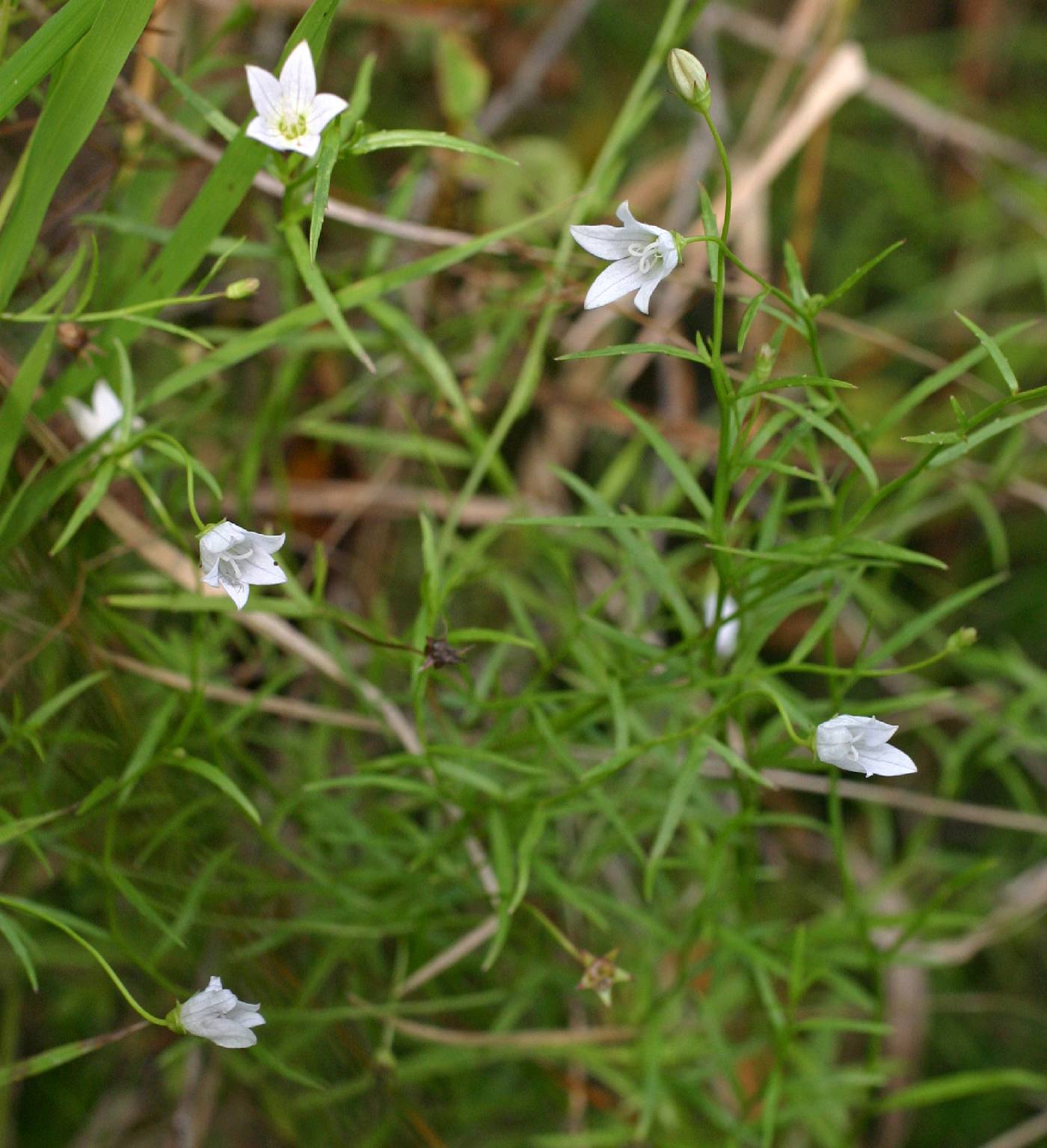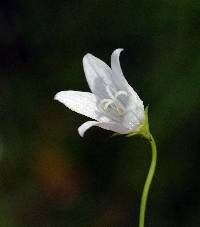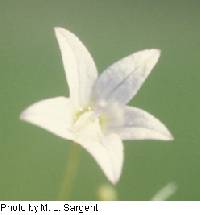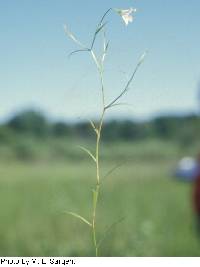|
|
|
|
Family: Campanulaceae
marsh bellflower
[Campanula aparinoides var. grandiflora Holz., moreCampanula aparinoides var. uliginosa (Rydb.) Gleason, Campanula uliginosa Rydb.] |
Perennial herb 20 - 60 cm tall Stem: weak, usually leaning on other plants, very slender, three-angled with rough edges. If the stem is broken or cut, it exudes milky sap. Leaves: alternate, stalkless, narrow (under 8 mm wide), 1.5 - 5 cm long, about six times longer than wide, lance-shaped, slightly toothed, with rough edges, and a rough midvein on the lower surface. Flowers: pale blue (or white), small, 0.4 - 1 cm long, funnel-shaped, radially symmetric, and arranged singly on 0.4 - 4 cm long, divergent stalks at the top of the stem. Sepals: five, but fused for up to 2 mm, then separating into 0.7 - 2 mm long, triangular to lance-shaped lobes. Petals: five, but fused for about half their length, then separating into somewhat triangular, ascending lobes. Stamens: five, with filaments attached to the very base of the petal tube. Pistil: with a single, three-chambered, inferior ovary; and a single style, which ends in a three-lobed stigma. Fruit: a many-seeded, three-chambered, 1.2 - 2 mm long capsule, which opens by pores near the base. Rhizomes: thin and threadlike. Similar species: In the Chicago Region there are two subspecies of Campanula aparinoides, the typical form as described above, and the more common C. aparinoides ssp. uliginosa, which tends to be larger overall with longer (2 - 9 cm) and narrower leaves, longer flower stalks (1 - 8 cm), and larger flowers (1- 1.5 cm long). Also similar is C. rotundifolia, but that species has erect, smooth stems, and larger flowers (1.5 - 3 cm long). Flowering: June to September Habitat and ecology: Occasional in marshes, wet sunny meadows, swales, calcareous fens, and shrubby or boggy sites. Occurence in the Chicago region: native Etymology: Campanula comes form the Latin word campana meaning bell, which refers to the bell-shaped flowers of the genus. Aparinoides refers to the species Galium aparine in the Rubiaceae family, to which the roughness of the stem and leaves are somewhat similar. Author: The Field Museum Perennial from filiform rhizomes, the stems weak, slender, usually reclining on other plants, somewhat 3-angled, scabrellate on the angles to nearly smooth; lvs linear or narrowly lanceolate, the lower to 9 cm נ8 mm, the upper shorter and proportionately narrower, often roughened on the margins and midvein beneath; fls solitary on long slender pedicels; sep triangular to lanceolate, 1.5-5 mm; cor funnelform, pale blue to white, 4-13 mm; fr opening at base; 2n=34, 68, 170. Wet sunny meadows; N.S. and Que. to Sask., s. to Ga., Ky., Mo., and Neb. June-Aug. Two vars.: Var. aparinoides with lanceolate lvs (the longer ones 1-5 cm, avg 6 times as long as wide), the cor 4-10 mm, the divergent pedicels often upcurved at the tip and with naked summit 0.4-4 cm, is the slender s. phase, extending n. to the Canadian boundary. Var. grandiflora Holz. (C. uliginosa), with linear lvs (the longer ones 2-9 cm, avg 12 times as long as wide), the cor 5-13 mm, the ascending pedicels with naked summit 1-8 cm, is the more robust n. phase, extending s. to Pa. and Io. Gleason, Henry A. & Cronquist, Arthur J. 1991. Manual of vascular plants of northeastern United States and adjacent Canada. lxxv + 910 pp. ©The New York Botanical Garden. All rights reserved. Used by permission. |





